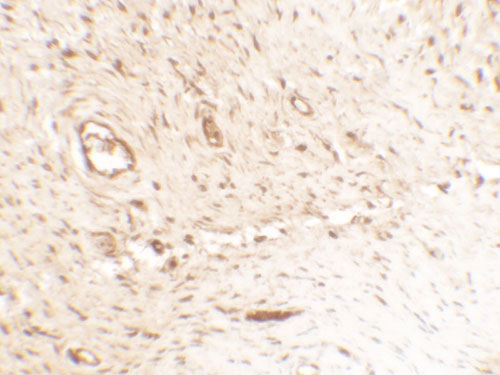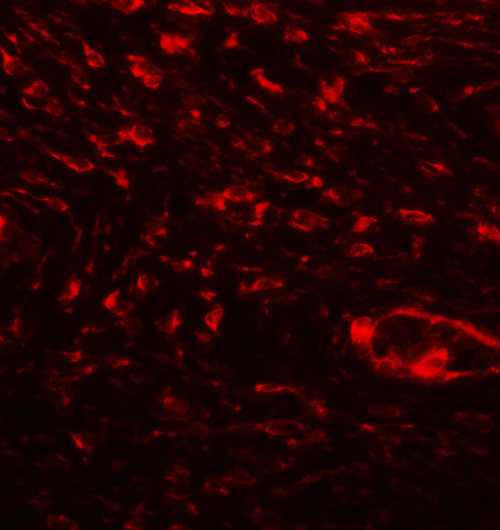SPP1 Antibody
- SPECIFICATION
- CITATIONS
- PROTOCOLS
- BACKGROUND

Application
| WB, IHC-P, IF, E |
|---|---|
| Primary Accession | P10451 |
| Other Accession | NP_001238759, 352962176 |
| Reactivity | Human, Mouse, Rat |
| Host | Rabbit |
| Clonality | Polyclonal |
| Isotype | IgG |
| Calculated MW | Predicted: 36 kDa Observed: 37 kDa |
| Application Notes | SPP1 antibody can be used for detection of SPP1 by Western blot at 1 - 2 µg/mL. |
| Gene ID | 6696 |
|---|---|
| Target/Specificity | SPP1; SPP1 antibody is human, mouse and rat reactive. Multiple isoforms of SPP1 are known to exist. |
| Reconstitution & Storage | SPP1 antibody can be stored at 4℃ for three months and -20℃, stable for up to one year. |
| Precautions | SPP1 Antibody is for research use only and not for use in diagnostic or therapeutic procedures. |
| Name | SPP1 |
|---|---|
| Synonyms | BNSP, OPN |
| Function | Major non-collagenous bone protein that binds tightly to hydroxyapatite. Appears to form an integral part of the mineralized matrix. Probably important to cell-matrix interaction. |
| Cellular Location | Secreted |
| Tissue Location | Detected in cerebrospinal fluid and urine (at protein level) (PubMed:25326458, PubMed:36213313, PubMed:37453717) Bone. Found in plasma. |

Thousands of laboratories across the world have published research that depended on the performance of antibodies from Abcepta to advance their research. Check out links to articles that cite our products in major peer-reviewed journals, organized by research category.
info@abcepta.com, and receive a free "I Love Antibodies" mug.
Provided below are standard protocols that you may find useful for product applications.
Background
SPP1 Antibody: The secreted protein 1 (SPP1), also known as osteopontin, is a major noncollagenous protein of bone, but is also found in the extracellular matrix of other mineralized tissues and in bodily fluids. In bone, SPP1 is produced by osteoblasts, osteocytes, macrophages, and osteoclasts (1,2). SPP1 binds to cells through integrin and non-integrin receptors, as well as the adhesion receptor CD44 in an RGD-independent manner, enabling SPP1 to induce a number of functional effects including macrophage chemotaxis, cytoprotection, and regulation of T helper type 1 cells (2). SPP1 can regulate biomineralization by inhibiting the formation of hydroxyapatite (3) and the growth of calcium oxalate crystals (4).
References
Heinegard D, Andersson G, and Reinholt FP. Roles of osteopontin in bone remodeling. Ann. N.Y. Acad. Sci.1995; 760:213-22.
Wang KX and Denhardt DT. Osteopontin: rule in immune regulation and stress responses. Cyto. Growth Factor Rev. 2008; 19:333-45.
Boskey AL, Maresca M, Ullrich W, et al. Osteopontin-hydroxyapatite interactions in vitro: inhibition of hydroxyapatite formation and growth in a gelatin-gel. Bone Miner. 1993; 22:147-159.
Shiraga H, Min W, VanDusen WJ, et al. Inhibition of calcium oxalate crystal growth in vitro by uropontin: another member of the aspartic acid-rich protein superfamily. Proc. Natl. Acad. Sci. USA 1992; 89:426-30.
If you have used an Abcepta product and would like to share how it has performed, please click on the "Submit Review" button and provide the requested information. Our staff will examine and post your review and contact you if needed.
If you have any additional inquiries please email technical services at tech@abcepta.com.













 Foundational characteristics of cancer include proliferation, angiogenesis, migration, evasion of apoptosis, and cellular immortality. Find key markers for these cellular processes and antibodies to detect them.
Foundational characteristics of cancer include proliferation, angiogenesis, migration, evasion of apoptosis, and cellular immortality. Find key markers for these cellular processes and antibodies to detect them. The SUMOplot™ Analysis Program predicts and scores sumoylation sites in your protein. SUMOylation is a post-translational modification involved in various cellular processes, such as nuclear-cytosolic transport, transcriptional regulation, apoptosis, protein stability, response to stress, and progression through the cell cycle.
The SUMOplot™ Analysis Program predicts and scores sumoylation sites in your protein. SUMOylation is a post-translational modification involved in various cellular processes, such as nuclear-cytosolic transport, transcriptional regulation, apoptosis, protein stability, response to stress, and progression through the cell cycle. The Autophagy Receptor Motif Plotter predicts and scores autophagy receptor binding sites in your protein. Identifying proteins connected to this pathway is critical to understanding the role of autophagy in physiological as well as pathological processes such as development, differentiation, neurodegenerative diseases, stress, infection, and cancer.
The Autophagy Receptor Motif Plotter predicts and scores autophagy receptor binding sites in your protein. Identifying proteins connected to this pathway is critical to understanding the role of autophagy in physiological as well as pathological processes such as development, differentiation, neurodegenerative diseases, stress, infection, and cancer.




